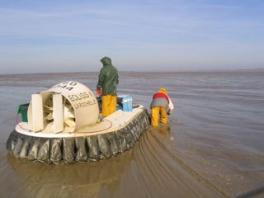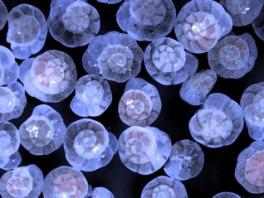|
Study
of the fate of bacterial production in mudflat : importance
and role within the benthic food web
Pierre-Yves
PASCAL PhD
2004-2007 Research
advisor: Nathalie
NIQUIL: Centre de Recherche sur les Ecosystèmes Littoraux Anthropisés
– UMR6217 - Unité Mixte de recherche CNRS, IFREMER, Université de La
Rochelle ; Avenue Michel Crépeau 17042 La Rochelle France Scientific
advisor: Chistine
DUPUY: Centre de Recherche sur les Ecosystèmes Littoraux Anthropisés
– UMR6217 - Unité Mixte de recherche CNRS, IFREMER, Université de La
Rochelle ; Avenue Michel Crépeau 17042 La Rochelle France Pierre
RICHARD: Centre de Recherche sur les Ecosystèmes Littoraux
Anthropisés – UMR6217 - Unité Mixte de recherche CNRS, IFREMER,
Université de La Rochelle ; Place du Séminaire B.P. 5 17137 L'Houmeau
France This
work is funded by Conseil Général
de Charente-Maritime (17), the programme ECCO, the programme
PNEC – Littoral Atlantique and the programme ANR – VASIREMI Keywords
Benthic
bacteria - mudflat - tracer – food web - stable isotope - grazing –
foraminifera – nematode – Hydrobia ulvae – inverse modelling – Marennes-Oléron Context
The development and application of improved methods for measuring
bacterial abundance and production have radically changed the perception
of bacteria compartment in pelagic marine systems. Bacteria are known to
play a role in the degradation of organic matter and the regeneration of
nutrients. But it’s now admitted that an important part of primary
production is consumed by higher trophic levels through the bacteria.
The “microbial loop” model
(e.g. Azam et al.
1983)
consider bacteria as
a “link” more than a “sink”, increasing the rate of primary
production available for higher trophic levels. Therefore, in pelagic
foodweb models developed, bacteria play frequently a major role
(e.g. Vézina &
Savenkoff 1999)
.
In marine soft sediments, bacterial abundance are relatively
constant at around 109 bacteria.ml-1 porewater
(Schmidt et al. 1998)
, being thousand time
more abundant than in pelagic systems. Moreover, high rates of
production
(Alkemade et al.
1992)
have been measured
in aquatic sediments
(e.g. van Duyl &
Kop 1990)
. Those points have
driven to a debate: is benthic bacterial production a carbon sink or
link in benthic food webs? Due to technical limitations, studies dealing
with benthic bacterivory are not developed as pelagic ones. Furthermore,
results of this studies varies greatly
(Kemp 1990)
so it is hard to
draw general conclusions about the importance of grazing as a fate for
benthic bacterial production. Aims
-
Elaborate a new method to quantify ingestion of bacteria by meiofauna (foramifera
and nematodes) and macrofauna (Hydrobia
ulvae). This technique is based on the pre-enrichment with stable
isotope of benthic bacteria in culture medium. Those bacteria are then
put in contact with their potential consumers. Evolution of gazers
isotopic composition is linked with an ingestion of enriched bacteria
and gives access to a bacterial ingestion rate. -
Determine bacterial ingestion rate of meiofauna and macrofauna in
experimental conditions according to various biotic and abiotic factors. -
Determine bacterial ingestion rate of meiofauna and macrofaune in
situ in the Brouage mudflat during the year 2006. -
Integrate data concerning the benthic bacterial compartment in an
inverse model of the benthic food web in the Brouage mudflat
(Leguerrier et al.
2003, Degré et al. 2006)
1
) Sampling in Brouage muflat ;
2) Ammonia tepida the most
common species of foraminifera Publications
Rossignol L, Dupuy C, Pascal
PY, Debenay J-P (In press) Hydrobia
ulvae: a deposit feeder for cleaning living hard-shelled
foraminifera. Journal of Foraminiferal Research Pascal PY,
Dupuy C, Mallet C, Richard P, Niquil N. (In prep). 15N
enriched bacteria method to quantify the bacterivory of benthic organism
in sediment. Environmental microbiology. Meetings
Pascal PY,
Niquil N, Dupuy C, Richard P, Mallet C, Debenay J P Bacterivory of foraminifera
(Ammonia Tepida) in intertidal mudflat according to various biotic and abiotic
factors. ASLO summer meeting, 4-9 June 2006, Victoria (British Columbia, Canada) Scientific outreach
Pascal P Y,
The bacterial film, Festival of the very short film of scientific
popularization, 2005, La Rochelle. Jury award, public award and high
school award. Reference
Alkemade R,
Wielemaker A, de Jong SA, Sandee AJJ (1992) Experimental evidence for
the role of bioturbation by the marine nematode Diplolaimella bruciei in
stimulating the mineralization of Spartina anglica detritus. Marine
Ecology Progress Series 90:149-155 Azam F, Fenchel T,
Field JG, Gray J, Meyer-Reil LA, Thingstad F (1983) The ecological role
of bacteria in the sea. Marine Ecology Progress Series 10:257-263 Degré D, Leguerrier
D, Armynot du Chatelet E, Rzeznik-Orignac J, Auget J-C, Dupuy C, Marquis
E, Fichet D, Struski C, Joyeux E, Sauriau P-G, Niquil N (2006)
Comparative analysis of the food webs of two intertidal mudflats during
two seasons using inverse modelling : Aiguillon Cove and Brouage Mudflat,
France. Estuarine and Coastal Shelf Science 69:107-124 Kemp PF (1990) The
fate of benthic bacterial production. Review Aquatic Science 2:109-124 Leguerrier D, Niquil
N, Boileau N, Rzeznik J, Sauriau PG, Le Moine O, Bacher C (2003)
Numerical analysis of the food web of an intertidal mudflat ecosystem on
the Atlantic coast of France. Marine Ecology Progress Series 246:17-37 Schmidt JL, Deming
JW, Jumars PA, Keil RG (1998) Constancy of bacterial abundance in
surficial marine sediments. Limnology and oceanography 43:976-982 van Duyl FC, Kop AJ
(1990) Seasonal patterns of bacterial production and biomass in
intertidal sediments of the western Dutch Wadden Sea. Marine Ecology
Progress Series 59:249-261 Vézina AF,
Savenkoff C (1999) Inverse modeling of carbon and nitrogen flows in the
pelagic food web of the northest
subartic Pacific. Deep-sea research II 46:2909-2939
|


